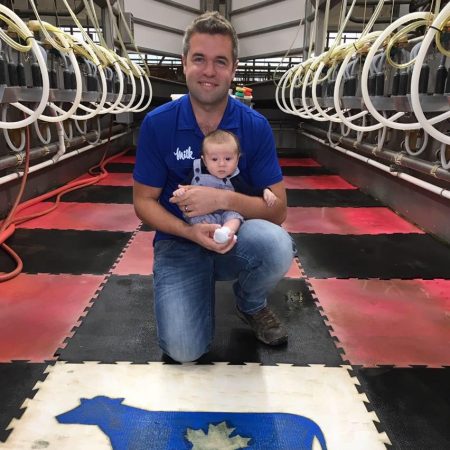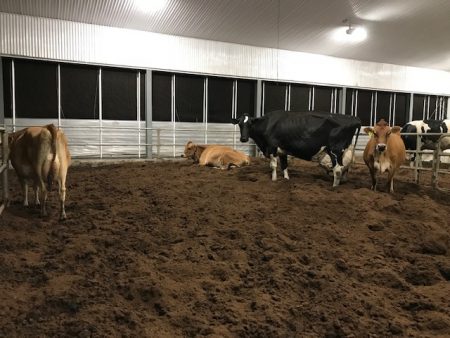 Last year I had the opportunity to contact an energetic 27-year-old dairyman who has enthusiastically selected the Jersey breed for his dairy operation. Listening to Tyler Hendriks of Seaforth Ontario as he talks about the dairy industry and Jersey breeding made me excited about the future possibilities for Jerseys.
Last year I had the opportunity to contact an energetic 27-year-old dairyman who has enthusiastically selected the Jersey breed for his dairy operation. Listening to Tyler Hendriks of Seaforth Ontario as he talks about the dairy industry and Jersey breeding made me excited about the future possibilities for Jerseys.
Young Mind – Fresh Start
After college in 2011, Tyler bought his retiring uncle Gerard’s milking herd and quota holdings. He rented his uncles 100 acre farm and milked in a tie-stall barn. Within two years he had added in half his father’s quota holdings. His grandparents had immigrated to Canada from The Netherlands, working factory jobs and dairy farming part-time. Eventually, Tyler’s father and uncle took over and divided the operation into two average sized neighboring tie stall farms. Tyler’s parents had farmed with a mixed breed herd however Tyler saw breeds differently and swapped out the Holsteins for an established Jersey herd. In his own words, Tyler commented on his bold start saying, ‘actually being responsible both for the management and labor in a tie stall barn was a big wake-up call for a guy just out of college’.
While attending college Tyler had formed strong friendships which he maintains with other young dairymen who represent other types of focus including an organic and grazing herd, a large herd with high performance and a large herd including high genomics and embryo marketing. All those herds have Holsteins but after doing much research and study Tyler determined his goal of total concept from field to milk sales could be best realized by farming with Jerseys.
Family Foundations

Tyler has the total support of his family – Emily, his parents and sisters, Brittney and Kylie. Noteworthy is the fact that Tyler’s parents gave him the opportunity to immediately be the dairy leader. Tyler and his wife Emily, who also grew up on a dairy farm and is a bank ag specialist, were married in 2016. They have a six-month son, Liam. Tyler gives much credit to Emily on the financial side as well as being willing and able to step in when needed for work or fine-tuning plans. Family time with Liam and off-farm time are important to Tyler and Emily. They both participate in CrossFit as a way to get off the farm and be active in their community.
Taking the Leap
In 2014, Tyler switched to a total Jersey herd when he combined the quota holdings of his uncle and half of his father’s quota for a total of 130 kgs of fat per day. At that time his herd was housed in a tie stall barn. In 2016 a new tunnel ventilated sand stall barn and double eight rapid exit parlor were built. This reduced the labor requirement and gave Tyler more opportunity to manage the milking herd at an elevated level. The Jersey herd came a whole herd, but Tyler found it necessary to cull especially on a production basis. His herd additions have been elite genetic heifers as they left the Progenesis Program. Currently (Jan ’19) the 93 Jersey cows are milked 3x with a daily average of 1.55 kgs (3.42 lbs.)F, 1.20 kgs (2.65 lbs.)P and 39.5 kg (87 lbs.) Energy Corrected Milk. SCC is 120,000 SCC, Pregnancy Rate is 30% and average days open is a remarkable 88 days. One important metric for Tyler is that his herd produces 2 kgs of Energy Corrected Milk for every 1 kg of Dry Matter consumed.

The calves are in hutches and fed 2x and weaned at 75 days. Younger heifers are housed in an old pig barn renovated by Tyler and Emily. Older heifers are housed in an older cow barn.
Tyler milks at two of the three milkings each day usually with his father or sisters. He employs a night milker and along with family this allows for family time, for harvesting to continue, for vacation time and for when he has meetings to attend.
Tyler quickly told me that his most important and ongoing mentor has been his father. To this day they usually have time during milkings to share, discuss and even, as Tyler says, to disagree. He was reluctant to start naming mentors as he has had and continues to have many. He values highly what he has learned from veterinarian Dr. Ray Reynen, when Tyler assisted him doing herd health visits to other farms, and also values the advice given to him by nutritionist Jesse Flanagan and his neighboring dairy farmers.
Fieldwork and cropping on 800 acres is on a shared basis between Tyler, his father, and his uncle. All forages are grown on the farm and they are stored in horizontal silos. High-quality corn silage is important as it forms 65% of the milking cow diet.
The Future is Information, Data Gathering and Improving Results
Tyler spends considerable time every day, except on the busiest harvest days, studying reports from Dairy Comp 305, searching the Internet for information and ideas, communicating on Facebook and participating in online webinars. He shared that at times he may feel slightly guilty for all the time at the screen. However, in the big picture, there is little doubt that the hours spent are yielding great returns to Hendriks Dairies.
To date, Hendriks Dairies does not have parlor ID but that plus many other tools are on Tyler’s consideration list. All will be evaluated on a cost-benefit basis on his Jersey farm.
I did ask Tyler – “Why Jerseys?”. His quick and progressive thinking mind came right back at me with “Well, Why Not? … Feed efficiency, smaller more docile cow who isn’t so hard on herself in a commercial environment, lower age at first calving, less health events, less animal labor per unit of output, high fertility, … do I need to give your more reasons?”.
Other Young Dairy People Also Interested in Jerseys
One year ago, The Bullvine produced articles on the very progressive Suntor Holsteins (Read more: Suntor Holsteins – New Baby, New Robot, New Perspective and Suntor Holsteins – Breeding Goals Revisited. Kevin and Amanda Sundborg, Master Breeders and owners of ‘Lightening’ nominated for Holstein Canada’s Cow of the Year (2019) have added a few Jerseys to their robotic farm. Why? Partially we have learned that it is because of Kevin’s friendship with Eric Silva (Sunset Canyon Jerseys, Oregon, US) and mostly because of seeing how productive, efficient, trouble-free and fertile the Jerseys are at Sunset Canyon. Are Jerseys the future at Suntor? Time will tell.

The Future is Officially Here
Tyler shared with me some interesting thoughts that I feel we all need to consider:
- It is facts and on-farm performance that should be the basis for all decisions
- Look down the road to how milk will be priced in 5-10 years at the farm gate
- The future pricing of milk will be for the solids not the fluid portion
- High fat milk should be transported and processed separately
- Jerseys can be 20+% of the national herd, provided Jersey breeders focus on productivity
- Much can be learned by studying very successful Jersey farms in the US
- Jerseys can work very well on automated farms – 3x or stall robots
- Dairying with Jerseys in the future will be about much more than average first lactation score and the show ring. The Ontario Jersey Benchmarking Service (Troew Nutrition – Jersey Ontario) is excellent for bottom-line focused breeders to compare their herd to other herds.
- More progressive Jersey thinkers need to be involved in farmer organizations
- Lifestyle and family are very important, take time for both
- Kevin Sundborg sees it as a total farm operation when he considers which breed suits best. It is the efficient use of all resources – facilities, land available, land value, topography, heat units, manure disposal, phosphorous run-off, investment in machinery, labor required and many more.
More thoughts on future Jersey breeding, heifers, feeding and managing from both Hendriks and Suntor Farms will be covered in a future article.
The Bullvine Bottom Line
Future Jersey dairy farmers can follow the examples of Tyler and Emily or Kevin and Amanda’s models for including Jerseys. It isn’t absolutely necessary to copy the program of others or to maintain a farm’s tradition. Always look for new ideas and ways to farm successfully. The keys to future dairying will be data and information, thinking of and implementing ways to use it to increase revenue per unit of input, control costs and farm each day to maximize profit. The future is now for innovative dairy farmers. Move forward. Be Awesome.

Get original “Bullvine” content sent straight to your email inbox for free.
Other posts you might like:







 Last year I had the opportunity to contact an energetic 27-year-old dairyman who has enthusiastically selected the Jersey breed for his dairy operation. Listening to Tyler Hendriks of Seaforth Ontario as he talks about the dairy industry and Jersey breeding made me excited about the future possibilities for Jerseys.
Last year I had the opportunity to contact an energetic 27-year-old dairyman who has enthusiastically selected the Jersey breed for his dairy operation. Listening to Tyler Hendriks of Seaforth Ontario as he talks about the dairy industry and Jersey breeding made me excited about the future possibilities for Jerseys.






